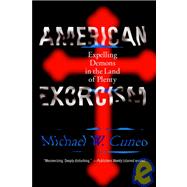
| Acknowledgments | |
| Introduction | |
| The Exorcist as Hero | |
| The Blatty Factor | p. 3 |
| Malachi's Hostages | p. 14 |
| Entrepreneurs of Exorcism | |
| Demon-Busters | p. 27 |
| Demonic Breakdowns | p. 41 |
| The Priest-Exorcist as Hero - Revisited | p. 59 |
| Charismatic Deliverance Ministry | |
| Heartland Deliverance | p. 73 |
| Pentecostalism Joins the Mainstream | p. 83 |
| The Heyday of Charismatic Deliverance | p. 96 |
| Discerning Demons | p. 111 |
| Exorcism as Therapy | p. 129 |
| The Rough-and-Ready School | |
| The Hegewisch Shuffle | p. 167 |
| Carolina Blues | p. 182 |
| The Rise of Evangelical Deliverance | |
| Satanic Conspiracies | p. 195 |
| On the Front | p. 217 |
| Roman Catholic Exorcism | |
| A Day at the Office | p. 239 |
| Official, Unofficial, Quasi-Official | p. 257 |
| Conclusion | p. 270 |
| Notes | p. 283 |
| Index | p. 303 |
| Table of Contents provided by Blackwell. All Rights Reserved. |
The New copy of this book will include any supplemental materials advertised. Please check the title of the book to determine if it should include any access cards, study guides, lab manuals, CDs, etc.
The Used, Rental and eBook copies of this book are not guaranteed to include any supplemental materials. Typically, only the book itself is included. This is true even if the title states it includes any access cards, study guides, lab manuals, CDs, etc.
Excerpted from American Exorcism: Expelling Demons in the Land of Plenty by Michael W. Cuneo
All rights reserved by the original copyright owners. Excerpts are provided for display purposes only and may not be reproduced, reprinted or distributed without the written permission of the publisher.